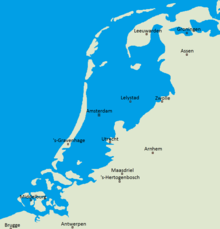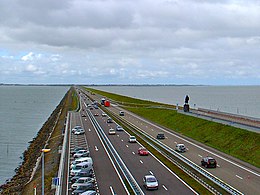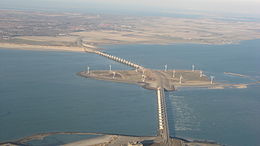Netherlands
![]()
This article is about the country within the Kingdom of the Netherlands. For other meanings, see Netherlands (disambiguation).
Template:Infobox State/Maintenance/NAME-German
The Netherlands (plural in German; Dutch Nederland and Frisian Nederlân, singular, informally Holland) is one of the four autonomous countries of the Kingdom of the Netherlands. Located largely in northern Western Europe, the country is bounded there by the North Sea to the north and west, Belgium to the south, and Germany to the east. The capital of the Netherlands is Amsterdam, and the seat of government is The Hague.
The territory of the Netherlands presented in this article includes, in addition to the twelve provinces of the European part, the Caribbean islands of Bonaire, Sint Eustatius and Saba (including their respective tributary islands), which are special municipalities of the country. Other Dutch Caribbean territories are not part of the country of the Netherlands, but are autonomous countries within the Kingdom of the Netherlands. These are the countries of Aruba, Curaçao and Sint Maarten.
After belonging to the Middle Kingdom, the East Francia and the Holy Roman Empire, the year 1581 with the Plakkaat van Verlatinghe is considered the birth of the United Netherlands, which was finally recognized in 1648 with the Peace of Westphalia. The Netherlands became a great trading, colonial and maritime power. The 17th century is described as the Golden Age. The constitution of the Netherlands dates back to the time of the Congress of Vienna in 1814/15.
Together with Belgium and Luxembourg, the Netherlands form the Benelux Union. The Netherlands is a founding member of the Coal and Steel Community of 1951, which evolved into several successors and the European Union (EU) in 1992.
Country name
The official name of the country in Dutch is Nederland. This is also the name that is taken for granted in the colloquial language for Dutch people. In German, however, the country is called "Netherlands" (plural); in German colloquial speech one often says "Holland". The name "Holland" refers to a former county in the west of the Netherlands. In 1815, the Kingdom of the Netherlands was founded. Holland was initially a province until 1843, when it was divided into the provinces of Noord-Holland (capital Haarlem) and Zuid-Holland (capital The Hague).
In Dutch, the term Holland or Dutch by all means is occasionally used ironically or to emphasize Dutch folkways. In football, the self-designation is also Holland, for example in the battle cry Hup Holland Hup. The Dutch tourism industry uses the internationally better known Holland in marketing in English, German and other languages.
However, in 2019, a government and business roundtable decided that the country should present itself as the Netherlands. The fear is that the term Holland will be associated with clichés such as tulips and windmills, while the country prefers to see itself as modern and cosmopolitan. They also want to divert the flow of visitors to the other areas and thus relieve the capital Amsterdam.
The country name Netherlands (plural) derives from history. At the end of the Middle Ages, the Netherlands were part of the dominion of the House of Burgundy. In the 15th century, under Charles the Bold, their lands were divided into the upper lands (the Duchy and the Free County of Burgundy and tributary lands) and the lower lands (Flanders, Artois with part of Picardy, Brabant, Holland, Luxembourg, etc.). In 1482 the Burgundian inheritance passed to the House of Habsburg. At that time, the hereditary lands were already divided into Lower, Inner and Upper Austria (around Vienna, Graz and Innsbruck), the coastal lands (on the Adriatic) and the foothills (on the Upper Rhine). Thus the designation Netherlands, Burgundian Netherlands or Habsburg Netherlands (initially Spanish Netherlands, since 1714 Austrian Netherlands) arose somewhat consistently. (The Burgundian Oberland - the duchy around Dijon, which had always been outside the imperial borders, i.e. today's Bourgogne region - was lost to France in 1493, as was the Free County around Besançon, today's Franche-Comté, in 1678).
In Dutch, the historical regions are also called de Lage Landen, i.e. the low-lying or low-lying lands, as there are no mountains and few elevations in the Netherlands. The northern Dutch provinces of the Union of Utrecht (Holland, Zeeland, Utrecht, Gelderland, Overijssel, Groningen and Fryslân) declared themselves independent from the sovereign Philip II of Spain on 26 July 1581. Independence from the Holy Roman Empire was proclaimed in the treaties of the Peace of Westphalia in 1648, and the territory roughly corresponded to the later Netherlands. The southern part of the territory, including Flanders, however, remained with the Empire; later it became the state of Belgium. One spoke then of the northern and the southern Netherlands.
The Congress of Vienna united north and south as an independent state Koninkrijk der Nederlanden once again for a short time. However, as early as 1830, the southern Netherlands declared itself independent under the name of Belgium. Belgica is the name of an ancient Roman province; since the Renaissance, the term has been used as the Latin name of the Netherlands, including its northern provinces.
In Middle Dutch, the adjectives dietsc (corresponding to German deutsch) denoted the Dutchlanguage. This gave rise to the English term Dutch.
See also: Dutch (name) and German (etymology)
Batavia is an ancient Latin name for what is now the Netherlands, referring to the Germanic tribe of Batavians who settled near the Rhine delta. The Dutch also called the present capital of Indonesia, Jakarta, Batavia during their colonial period.
Geography
Landscape
About half of the country is less than one metre above sea level, and about a quarter of the country is below sea level (measured near Amsterdam; see picture on the right). The flat areas are usually protected from storm surges by dikes, which have a total length of about 3,000 km. The highest point in the Netherlands, at 877 metres, is Mount Scenery on the Caribbean island of Saba. The highest point on the mainland, the Vaalserberg in the extreme south, in the province of Limburg in the border triangle with Germany and Belgium, is 322.5 m above the Amsterdam water level.
Parts of the Netherlands, such as almost the entire province of Flevoland, were reclaimed from the sea by land reclamation. They are called polders (on the German North Sea coast Koog or Groden). The largest land reclamation project is associated with the Zuiderzee works. In 1932 the 29 km long final dike was completed, which separated the Zuiderzee sea bay from the North Sea. Several freshwater lakes were created in the area of the former sea bay, of which the IJsselmeer makes up the largest part. Of the polders created, the Flevopolder is the largest. It is (depending on the calculation) the largest artificial island in the world.
The most important rivers in the Netherlands (de grote rivieren - the big rivers) are the Rhine, Meuse and Scheldt. They divide the country into a north and a south The Rhine river comes from the German North Rhine-Westphalia and is a border river for a short distance. It soon branches out, thanks in part to canals that have been built to better distribute the water masses. The branches of the Rhine eventually join the Meuse, which comes from Belgium. Only in places are the rivers still called the Rhine, the Nederrijn or the Oude Rijn. The rivers shape the west of the Netherlands, the Rhine-Meuse delta. An important arm flows through Rotterdam and then at Hoek van Holland into the North Sea, other arms connect the rivers with Amsterdam and the IJsselmeer. Of the Scheldt, only its estuary lies north of Antwerp, Belgium, in the Netherlands.
The main wind direction is southwest, resulting in a temperate maritime climate with cool summers and mild winters. Especially in the west of the country, on the North Sea coast, the climate is more Atlantic (mild winters, cool summers). Towards the east, the Atlantic influence decreases somewhat, so that in the vicinity of the German border one can speak of a sub-Atlantic climate with somewhat colder winters (mild to moderately cold) and slightly warmer summers.
See also: Geology of the Netherlands and Flanders and Delta Works
Natural sights
- De Hollandse Biesbosch, a river and marsh landscape
- National Park Weerribben-Wieden
- The Hoge Veluwe and Veluwezoom National Parks in the Veluwe region
- The nature reserves on Texel
- Oostvaardersplassen, a nature development area that is now home to the largest herds of wild animals in Europe
- Reeuwijkse Plassen near Gouda
- Nieuwkoopse Plassen
- Schiermonnikoog
- The Deltawerke: protective weirs against storm surges, built after the storm surge of 1953
- De Meinweg National Park near Roermond in the province of Limburg

Areas of the Netherlands below sea level

The final dike, built in 1932, separates the IJsselmeer from the North Sea.

The Oosterscheldekering storm surge barrier is part of the Delta Works
Questions and Answers
Q: What is the Netherlands part of?
A: The Netherlands is part of the Kingdom of the Netherlands.
Q: Where is most of the Netherlands located?
A: Most of the Netherlands is located in Western Europe.
Q: How many people live in the Netherlands?
A: More than 17 million people live in the Netherlands.
Q: What countries border the European part of the Netherlands?
A: To the north and west, there is the North Sea; to the east, there is Germany; and to the south, there is Belgium.
Q: What organization did The Netherlands help found?
A: The Netherlands helped found the European Union.
Q: Who are people who live in The Netherland called? A: People who live in The Netherland are called "Dutch".
Q: What language do people speak in The Netherland? A: People in The Netherland speak Dutch.
Q:What are two cities that have important roles for government activities in The Netherland ? A:The official capital of The Netherland is Amsterdam and government activities take place mainly at The Hague.
Search within the encyclopedia